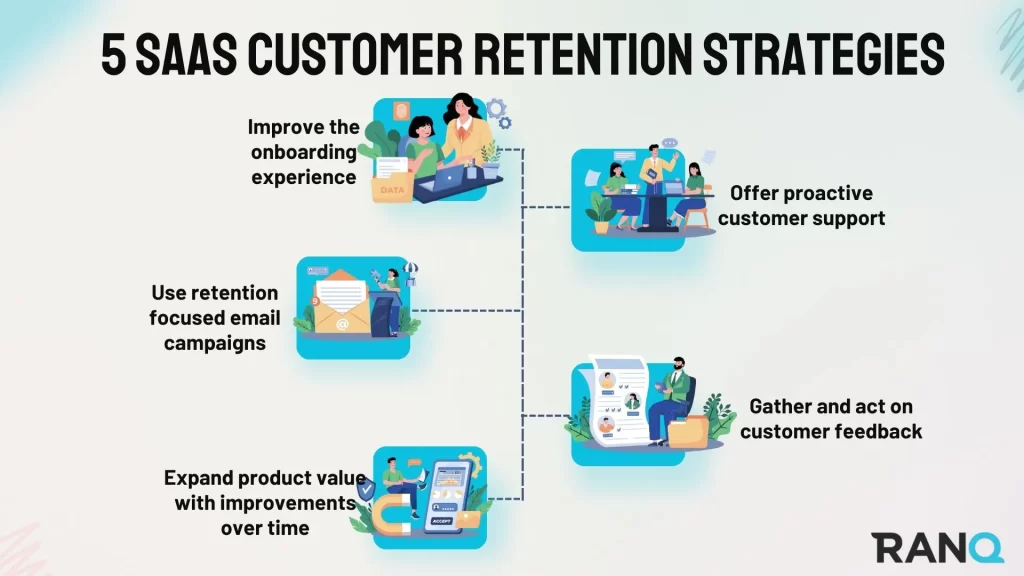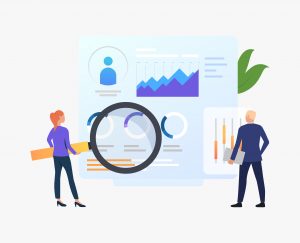Last updated on August 26th, 2025
As a SaaS founder, marketer, or customer success lead, it can sometimes seem like your customer retention strategies are unpredictable despite your best attempts to keep your customers engaged and subscribed. New acquisitions may appear more appealing than retention, but acquiring a new customer is five to seven times more expensive than retaining a current one. In this article, we will detail five SAAS retention strategies that actually work.
What is a SAAS customer retention strategy?

But what specifically is a customer retention strategy? It’s a series of plans and initiatives that your business or company can implement to preserve its current users and make its existing customers more profitable. For a SaaS company, this means having customers continue to renew their subscriptions or continue to try your new features and products.
Returning customers aren’t just valuable, but can be worth up to ten times more than new customers. And especially in the context of SaaS companies where the industry is constantly in flux , retention is crucial as your SaaS competition will constantly be trying to innovate, and you need to keep pace.
Why is SAAS customer retention important?
Customer retention is where SaaS companies can actually earn revenue, as it increases the lifetime value of your customer when they’re happy with your services.
And it lowers the chances of them telling others about negative experiences with your product. Based on research, dissatisfied customers will typically tell at least 15 people about their experience, while neutral and happy customers are less likely to leave reviews at all.
Further, high customer retention can lead to benefits such as repeat purchases, referrals, and customer feedback. It’s also essential for your reputation to offer good customer service that keeps people coming back. This can be achieved by prioritizing your customers’ satisfaction, building strong relationships, offering excellent customer support, and providing continuous innovation, transparency, and communication.
5 successful SAAS customer retention strategies

In the next section, we will discuss five SAAS customer retention strategies that can reduce churn and increase customer satisfaction. Customer satisfaction is directly related to the continued retention of those customers.
1. Improve the onboarding experience
The first step with customer retention is making sure that your customer has an easy, frictionless experience with your onboarding. First impressions can dictate everything, and most customer churn happens in the first 7-30 days of a user’s experience with a software. Consider on a high level how you onboard new customers and ensure that you have not only fulfilled all of the customer’s needs, but also offer a distinct eureka moment (also known as an “activation event”) for the customers that clarifies the value of your services. Over 99% of companies use at least one SaaS provider, you need to be able to stand out.
Once they’re using the software, make sure that there are tutorials, FAQs and service directories available through different channels that can address any of the users’ issues or confusion. When designing these tools, think about how to thread the needle between holding the users’ hand and bombarding them with pop-ups and tutorials. There needs to be a middle ground that feels engaging without distracting the user.
When examining your own onboarding process, ask these questions:
- What is the first thing a customer sees when they log in? Is it helpful?
- Do you guide the customer to relevant places?
- Is it easy for new customers to see your product’s value?
- Do you provide new customers with relevant resources?
If any of these questions are not sufficiently answered by your own onboarding process, this is the time to tweak and adjust the onboarding steps to improve your customer retention.
2. Offer proactive customer support
Customer support usually falls into two categories of approach: reactive and proactive. Proactive customer support involves anticipating customers’ issues and then solving them before they can lead to churn. Reactive support is when a company addresses churn after it happens and aims to win back lost users. Through proactive support, you can solve problems before they escalate.
Proactive support can come in many forms including in-app help prompts, check-in emails after certain user behaviors,, and early warning systems for possible red flags with a particular account. This is where your relationship managers work to repair these relationships before those customers can unsubscribe. With consistent proactive support, you can convert these satisfied users into customers or have more leverage to upsell your consumers with other features or integrations.
3. Use retention-focused email campaigns
If you want to try email marketing to attract new users or retain customers, you must be very deliberate about your approach. Lifecycle email marketing is one strategy for sending targeted, personalized emails to customers at different stages of their journey with your brand. With context about your customer’s place with your product and tailored messaging, your email marketing campaign can be an effective tool for re-engagement, feature education, or upselling.
Here are a few types of email campaigns that you could implement as a part of your SAAS retention strategy:
- Re-engagement emails for inactive users -Don’t just email the same message to every customer. Find a pain point that you can speak to within a re-engagement email.
- Product education series – For users who are in the early stages of awareness with your service, these emails can offer insight into your brand and how it solves specific problems.
- Upgrade nudges or feature announcements – For users in the engagement and loyalty stages, upgrades and feature announcements will be particularly appealing.
- Usage summaries – For loyal customers, they can see how they’re using your service and its effectiveness at their business.
With these targeted email campaigns and aligned content to match, you’ll be able to affirm your value to existing customers while also bringing in new traffic through educational blogs and other materials. If you need help creating substantial content, consider the experts at Ranq, who build SEO strategies and blogs tailored to each stage of your SaaS customer journey.
4. Gather and act on customer feedback
Another effective SAAS customer retention strategy is to gather and act on customer feedback on your product. As a SaaS company, you’ll want to find the data on NPS (Net Promoter Score), CSAT (Customer Satisfaction), and specific user sentiments or feature requests.
To briefly define NPS and CSAT metrics, net promoter score is a metric used to gauge customer loyalty from 0-10. To calculate the NPS, you will simply subtract the percentage of promoters (9’s and 10’s) from the percentage of detractors (0’s through 6’s).
And CSAT, or customer satisfaction score, is another scoring system that’s rated from 1-5 in order of satisfaction. To calculate the CSAT, add the total number of respondents who answered 4 or 5, divide that number by the total number of responses, and multiply that by 100 to give you a percentage.
You can collect this feedback in several ways, including through in-app surveys, exit surveys, emails, or support tickets. Like proactive customer support, you should respond to feedback promptly and with follow-through. If specific features are repeatedly requested, prioritize them for the next updates.
And whether you’re receiving input about confusing UI choices or an overpriced subscription model, those are clear examples that you need to adjust parts of your service or your messaging. You want your customers to be happy; they will be more likely to stick around.
5. Expand product value with improvements over time
As a SaaS company, you must remember that your software needs to continually expand and showcase your progress toward feature updates, performance boosts, UX improvements, or new integrations.
You could employ several methods to indicate these developments to your users, including product changelogs, in-app announcements, monthly update emails, or even introducing beta programs for frequent customers. All of these initiatives are steps to building long-term loyalty with your users and customers.
Ensure that you are always working toward (or at least giving the reasonable impression) that your service is innovating. Whether it’s regular bugfixes of feature tweaks, you need to be able to show that your product’s value is always rising.
How do you measure customer retention?

There are several SaaS-specific retention metrics that you should understand and keep in mind with your own company’s performance. They include:
- Churn Rate: This is the inverse of your retention rate. It looks at the percentage of customers who stopped using your SaaS over a period of time. ChurnZero is a great tool for tracking and preventing churn.
Formula: (Customers lost during a specific period / Total number of customers at the beginning of the period) × 100
- Customer Lifetime Value (CLV): Customer lifetime value is the total projected revenue from a single customer over the course of their full relationship with your product. By understanding this metric, you can identify opportunities to improve your customer journey, see the potential profitability of your business, and know when your marketing budget is unviable (when your acquisition costs exceed the CLV).
Formula: Customer Lifetime Value equals average revenue per user/churn rate
- Net Revenue Retention (NRR): Includes upsells, cross-sells, and downgrades. This is critical for understanding growth without new customers. A rate above 100% signifies that the company is not only retaining its existing revenue but also expanding it through existing customers.
Formula: (Recurring Revenue at end of period – revenue lost from churn + expansion revenue) / starting revenue × 100
- Customer Health Score: Also known as the customer engagement score, the customer health score is a measurement of how engaged a customer is with your product. The higher your customer’s health score, the less likely they are to churn. It is a predictive metric based on product usage, support tickets, NPS, etc.
Formula: In contrast to other formulas, customer health score requires you to weigh certain actions and operations that happen within your app within a certain time frame, and add them all together. Each of these functions is known as a total action value and can be calculated by multiplying the weighted action item by the frequency of that action within a time period.
Customer retention is important – RANQ can help!
As the saying goes, “the customer is always right,” and that’s the truth in any industry. But customer satisfaction can make or break you in the SaaS business, as customer retention depends on how you address your users’ needs. Whether it’s targeted email campaigns, adjusting onboarding, or gathering data, your SAAS customer retention strategies need to be substantive, direct, and demonstrate your product’s value.
The best way to do that is to provide valuable blog and site content that’s helpful for your existing clients and for bringing in new leads at the same time. If you want to hire pros who know how to align insightful, educational content with the best SEO practices, Ranq can help.



